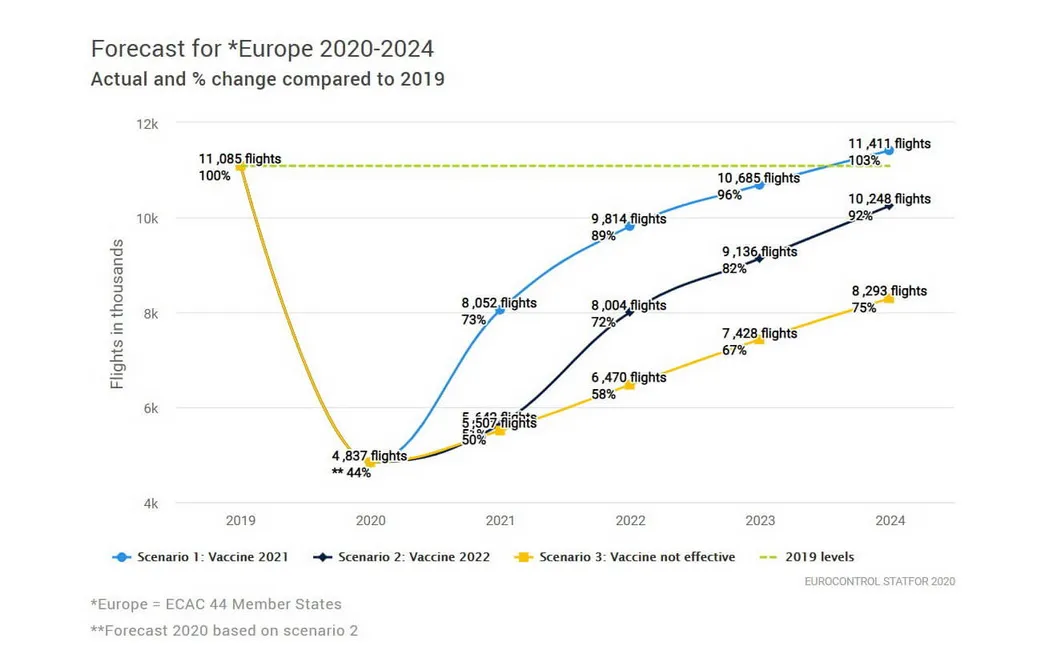
One of the biggest losers of the current Covid crisis is the tourism industry and, in particular, the aviation industry, which has seen massive halt inactivity in the last couple of months due to extensive travel restrictions worldwide. The air traffic in Europe is no exception.
In this context, The European Organization for the Safety of Air Navigation, commonly known as EUROCONTROL, analyzed the evolution of the European air traffic in the next couple of years up to 2024 and unveiled some interesting implications.
Drastic Decrease and Past Crises
In the period between March and October this year, there were 65 % fewer flights than during the same time last year. This decrease signifies that air traffic has returned to the levels before the 1990s. At the same time, according to experts, the GDP for the Euro Area is set to shrink by 7.5% during the year.
This is a big blow for the aviation industry, and it will very likely take a long time before it manages to respond to this shock and return to the pre-crisis levels. But how long exactly? Firstly, it is necessary to have a look at how the industry responded in the past two previous crises.
The two events chosen by EUROCONTROL were the 9/11 terror attacks and the great financial crisis 2008-11. After the attack on the World Trade Centre in 2001, it took the European air traffic industry 1.5 years to return to the 2001 levels. 200 thousand flights were lost until the recovery.
The financial crisis was somewhat more problematic, as it resulted in 600 thousand lost flights and it took the industry 8 years to return to the 2008 levels of air traffic.
Three Scenarios to Recovery
So where does the Covid-19 pandemic stand compared to the above-mentioned crises? At this point, what is sure is that 6 million flights were lost.
However, recovery time is uncertain and depends on several factors. These vary from the strength of the second wave of the pandemic to state aid to the industry as well as the potential introduction of a universal vaccine to cure the virus.
Taking these factors into account, EUROCONTROL came up with three potential scenarios that could unfold in the years to come.

The first scenario assumes that either the pandemic will come to an end by next summer or that a vaccine will be extensively available for air travelers in the same period. This would result in a boost in passenger confidence as well as an increase in testing infrastructure and facilities. At the same time, airlines would return to normal economic activity and would once again be able to invest and re-hire personnel. At this growth rate, a recovery to the pre-pandemic levels would be possible in 2024.
Based on the second scenario, the above-mentioned would happen by the summer months of 2022. In this case, air traffic in Europe would return to 2019 levels in 2026.
The final and most negative scenario assumes that the pandemic will go on for a long time and this will result in continued low passenger confidence. In this case, the vaccine will be available by summer 2022, but will not be distributed in a consistent manner worldwide.
In this scenario, airlines will have enormous difficulties to operate as in the pre-crisis period as a result of various new regional virus outbreaks. The demand for air travel will renew for about two-thirds of the population, but there will be an overall hesitation with regards to this means of transport. Thus, in this setting, recovery would be unlikely to arrive sooner than in 2029.
All in all, at this point it is difficult to predict how air traffic in Europe will evolve in the coming years. However, the next months could indicate which path we have embarked on and thus also the potential recovery time of the aviation industry.










